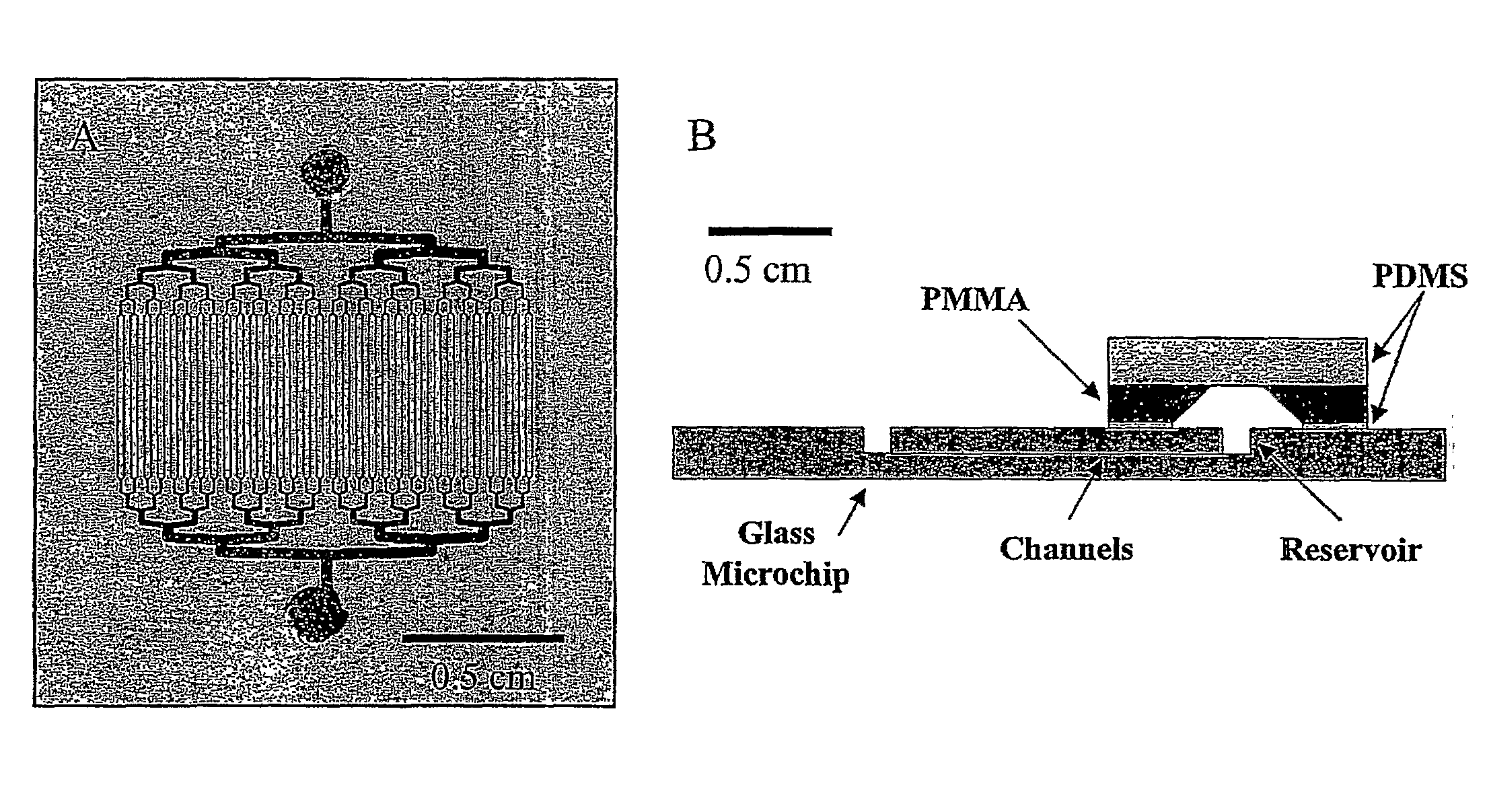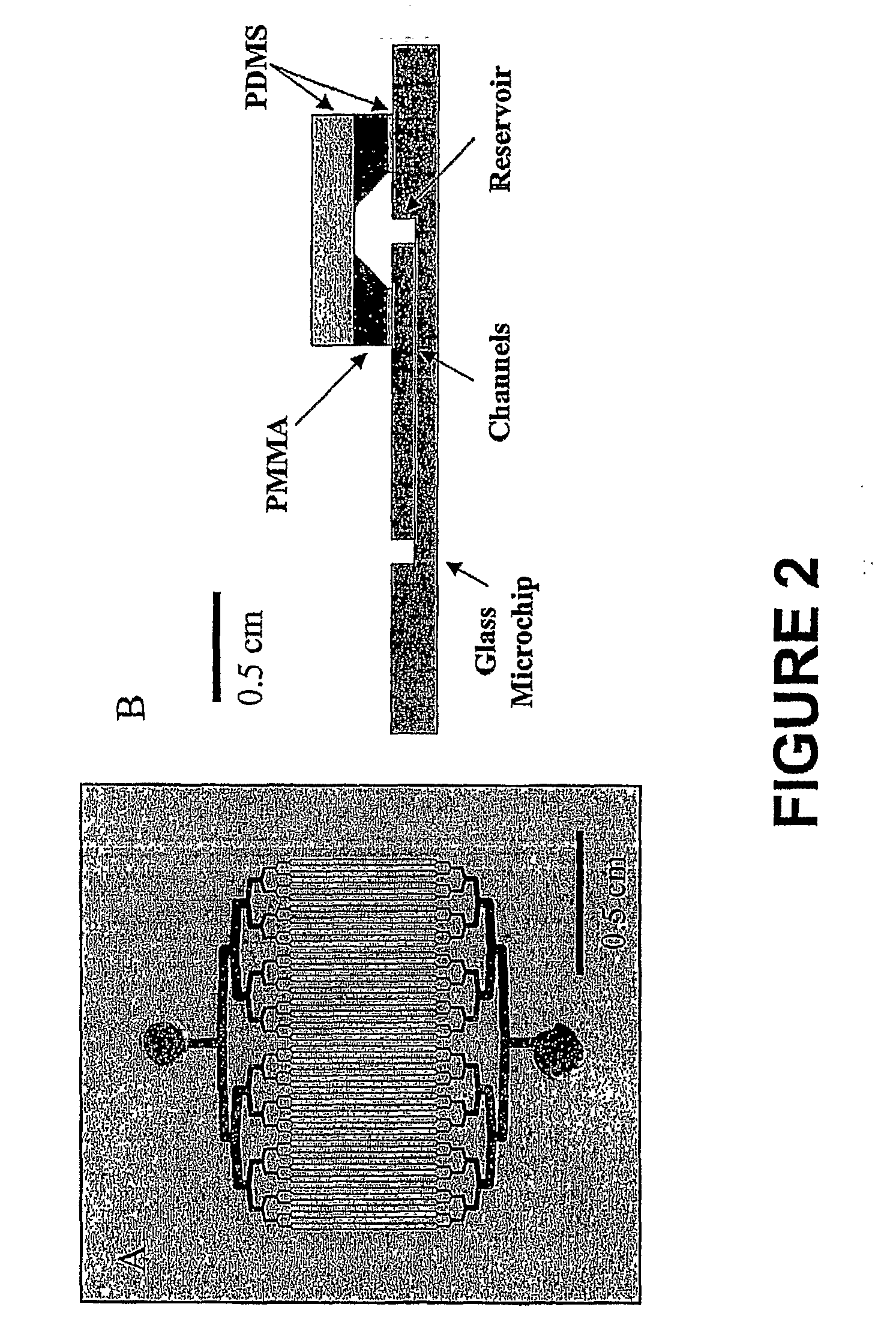Nucleic acid isolation methods and materials and devices thereof
- Summary
- Abstract
- Description
- Claims
- Application Information
AI Technical Summary
Benefits of technology
Problems solved by technology
Method used
Image
Examples
example 1
Purification of DNA Using Silica Beads Coated with Chitosan / Sol Gel Copolymer
[0053]Before coating, silica beads were cleaned in piranha solution (2:1, H2SO4:H2O2) at 70° C. for 10 min. Then the beads were washed to neutrality with water and dried thoroughly. Chitosan coating of the treated silica beads was accomplished through incubation with 0.1% GPTMS, which provides the crosslinker between the silica beads and chitosan, and 1% chitosan. The beads were then cleaned with 10 mM acetic acid and water to wash unbound chitosan off the beads.
[0054]The DNA extraction procedure consisted of load, wash, and elution steps. In the load step, 60 μg of chitosan-coated silica beads were mixed with a solution containing DNA and allowed to react for 10 min in a polypropylene tube. After centrifugation at 5000 rpm for 10 sec, the load solution was removed from the tube. The beads were further washed by 20 μl of 10 mM MES (pH 5.0) buffer for 5 min. The washing solution was removed after another bri...
example 2
DNA Purification in Multi-Channel Microchips Coated with Chitosan / Sol Gel Copolymer
[0060]The multi-channel extraction microchips were fabricated using standard photolithographic techniques. From the sample inlet, channels were divided through binary lamination according to the method of He et al. (Anal. Chen. 1998, 70:3790-3797) until 64 parallel channels were obtained, then rejoined into one channel at the outlet reservoir as shown in FIG. 2A. A 1.1 mm diameter access hole was drilled at each reservoir. A complete device was formed by thermal bonding of the etched plate with a cover plate at 640° C. To ensure that sample solution evenly diffused from a single inlet channel into multi channels, the inlet and outlet architecture was designed similar to that of He et al. With splitting of the channel, the channel dimensions decreased as the ratio of 2n. This design provided the same linear flow velocity at all points. The final number of channels (C) serving for DNA extraction was exp...
example 3
Microchip-Based Purification of Genomic DNA from Blood Samples
[0065]The extraction efficiency of the chitosan-coated open channel microchip was determined above for prepurified DNA, but while the proteins in whole blood did not significantly affect the capacity of the microchip, the extraction efficiency from whole blood had to be determined. A 4 μL whole blood sample was mixed with 36 μL of lysis buffer, then 2 μL of this mixture (0.2 μL of the original blood sample) was loaded onto the microchip at the rate of ˜1 μL / min. Following the usual wash step, the DNA was released by elution with 2 μL of elution buffer which was determined to contain 5.1±0.3 ng (n=3). Assuming that 5000 white cells were present per μL of blood sample, the amount DNA in the 0.2 μL of loaded blood was estimated to be 7.0 ng. The whole blood DNA extraction efficiency by microchip, therefore, was 75±4% (n=3). This demonstrated that the chitosan-coated open channel microchip design could be used to successfully...
PUM
| Property | Measurement | Unit |
|---|---|---|
| Composition | aaaaa | aaaaa |
| Magnetism | aaaaa | aaaaa |
Abstract
Description
Claims
Application Information
 Login to View More
Login to View More - R&D
- Intellectual Property
- Life Sciences
- Materials
- Tech Scout
- Unparalleled Data Quality
- Higher Quality Content
- 60% Fewer Hallucinations
Browse by: Latest US Patents, China's latest patents, Technical Efficacy Thesaurus, Application Domain, Technology Topic, Popular Technical Reports.
© 2025 PatSnap. All rights reserved.Legal|Privacy policy|Modern Slavery Act Transparency Statement|Sitemap|About US| Contact US: help@patsnap.com



